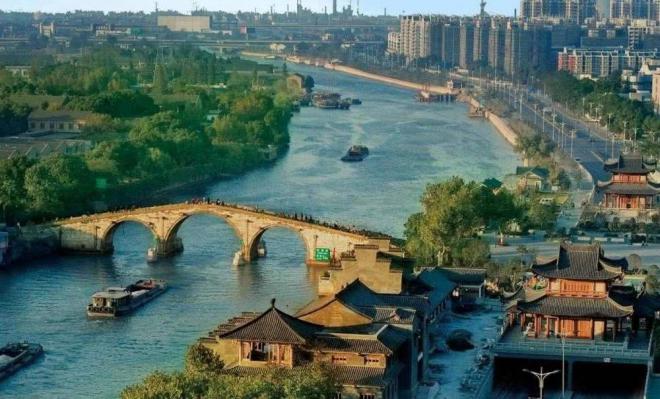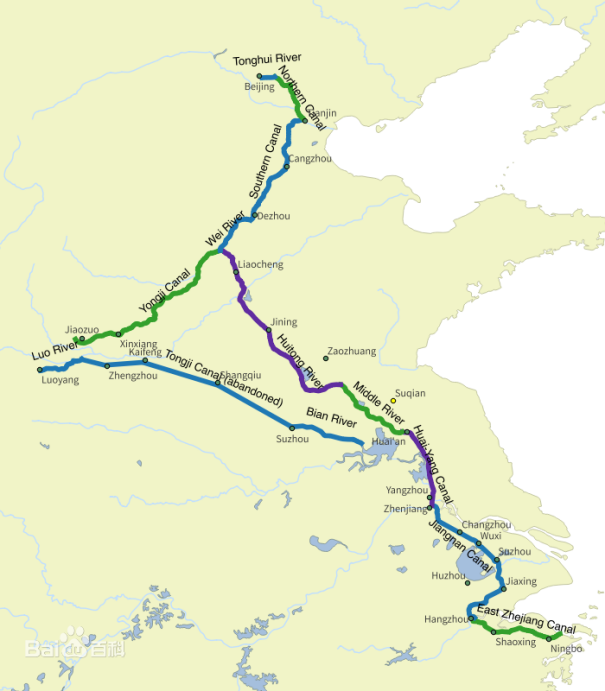| # | Time | Title | Contents |
|---|---|---|---|
| 1 | 486 BC | The Beginning Construction of the Grand Canal | The Grand Canal started to be built |
| 2 | 605 AD | Tongji Canal was built | Tongji Canal was built |
| 3 | 608 AD | Yongji Canal was built | Yongji Canal was built |
| 4 | 610 AD | Jiangnan Canal was built | Jiangnan Canal was built |
| 5 | 1079 AD | Bianhe River Cleaning Project | The Bianhe River Cleaning Project was carried out to solve the problem of siltation caused by the diversion from the Yellow River to the Bianhe River. A 25-kilometer channel was opened to directly lead the water of Yiluo basin into the Bianhe River, which was no longer connected to the Yellow River. |
| 6 | 1282 AD | Dig Jizhou River | Diverting Guangshui River, Wenshui River and Sishui River as water sources, Jizhou River was dug 75-kilometer to the north with Jining as the starting point. |
| 7 | 1411 AD | Expansion and renovation of Huitong River | Diverting the Wenshui River to Nanwang Lake. Utilizing the favorable topography of Nanwang Lake to build Nanwang Water Tank |
| 8 | 1959 | Focused on the expansion of the 400-kilometer canal section from Chuzhou to the Yangtze River | Combined with the South-North Water Transfer Project, focusing on the expansion of the 400-kilometer canal section from Chuzhou to the Yangtze River. |
| # | Contents | Photos |
|---|---|---|
| 1 | The Beijing-Hangzhou Grand Canal is a great project created by the working people of ancient China. It is a precious material and spiritual wealth left to us by our ancestors, and s a living and flowing important human heritage. The Beijing-Hangzhou Grand Canal was first constructed in the Spring and Autumn Period, formed in the Sui Dynasty, and developed in the Tang and Song Dynasties, which has a history of 2,500 years. Under the order of Emperor Qin Shi Huang (Yingzheng), an important river channel was dug in Jiaxing that laid the future trend of the Jiangnan Canal. According to Yuejue Shu, Emperor Qin Shi Huang ordered that repairing Lingshui canal to the Qiantang area and made it link Zhejiang. About 2500 years ago, the king of the state of Wu, Fu Chai, ordered to dig Hanhou which was connected with Yangtze River and Huai River, and to build Han City. Canal and canal culture were derived from this period. The Grand Canal we mentioned today was first constructed in the Spring and Autumn Period, completed in the Sui Dynasty, prospered in the Tang and Song Dynasties, dug straightly in the Yuan Dynasty, and dredged in the Ming and Qing Dynasties (it was first constructed from 486 BC and achieve full navigation in 1293 AD), which was constructed for 1779 years. The Grand Canal mainly experienced three large-scale construction processes in the long years. In the Sui Dynasty, Emperor Yang used millions of people to dig the Grand Canal and made it connected, which made a great contribution to the unprecedented economic and cultural prosperity of the country. The Grand Canal achieved full navigation in the Sui Dynasty, developed in the Tang and Song Dynasties, and became a traffic artery in the Yuan Dynasty that linked five great rivers including the Hai River, the Huai River, the Yangtze River, the Yellow River and the Qiantang River, and linked the South and North of China. |
| # | Contents | Photos |
|---|---|---|
| 1 | The flow direction, water source and discharge conditions of the Beijing-Hangzhou Grand Canal are different in each section, which is very complicated. The flow direction is generally summarized as four nodes and five flow directions. Node 1: The Tonghui River and te Beiyun River north of Tianjin (Haihe)flow southward. Node 1 and Node 2: The Nanyun River and the Lubei Canal between Dongping Lake flow northward. Node 2 and Node 3: Lunan Canal, Zhong Canal and Li Canal between the Yangtze River (Qingjiang) flow southward. Node 3 and Node 4: The section between Danyang south of the Yangtze River flows northward. The section south of Danyang (Jiangnan Canal) flows southward. After the founding of the People’s Republic of China, a large-scale renovation of the canal was carried out to enable it to regain its multiple functions of shipping, irrigation, flood control and drainage. The Beijing-Hangzhou Canal and Qiantang River communication project, which was completed at the end of 1988, has connected rivers and seas, forming a water transportation network centered on Hangzhou, and based on the connection of the Beijing-Hangzhou Grand Canal and the Yangtze River, Yellow River, the Huai River, and Qiantang River. After the completion of the second channel of the Grand Canal, the level of the Beijing-Hangzhou Grand Canal will reach Level 3, and ships of 1,000 tons will be able to reach Hangzhou, Zhejiang from Dongping Lake, Shandong at that time, with a 40% increase in shipping capacity. |


| # | Contents | Photos |
|---|---|---|
| 1 | With a length of 11.4km, the Beijing-Hangzhou Grand Canal (the section in Tongzhou City) is officially open | http://www.bjnews.com.cn/feature/2019/10/03/632340.html |
| 2 | The world’s longest canal: the Beijing-Hangzhou Grand Canal with a length of 1794 kilometers | https://tech.qq.com/a/20100114/000365.htm |
| 3 | General Office of the CPC Central Committee and General Office of the State Council issued the Outline of the Protection, Inheritance and Utilization of Culture of the Grand Canal | http://www.bjnews.com.cn/news/2019/05/09/577137.html |
[1] Jintao,LiabHongfa,ZhangaZong,etc.Spatiotemporal variations of land urbanization and socioeconomic benefits in a typical sample zone: A case study of the Beijing-Hangzhou Grand Canal[J].2020(117):1-10.
[2] Xie Bin, Li Xiang, Yu le, etc. An Analysis of the Change of the Beijing-Hangzhou Grand Canal (Hangzhou Section) and Its Impact on the Industrial Pattern[J]. Remote Sensing For Land & Resources, 2010(3):76-79.
[3] Jiang, T.T., Shi, L., Li, W.,Zhang,etc.Spatio-temporal distribution of Oncomelania hupensis snails along the Danyang section of the Beijing-Hangzhou Grand Canal and the Danyang-Jintan-Liyang Canal[J].2020,32(1):10-14.
[4] Wei, Q.Negotiation of Social Values in the World Heritage Listing Process: A Case Study on the Beijing-Hangzhou Grand Canal, China[J].2018,14(3):501-526.
[5] Yan, Y,Gao, Y.Forecasting the quality of Nansi Lake water after the construction of the new channel of the Beijing-Hangzhou Grand Canal[J].2016,14(11):822-827.
[6] Li, D.-L.,Ji, Y.-K,Dai, X.-H.,etc.Effect of riverside shelter forest communities protecting embankment from erosion in Huai'an section of the Beijing-Hangzhou Grand Canal[J].2013,29(6):705-710.